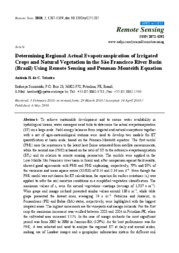Determining regional actual evapotranspiration ofirrigated crops and natural vegetation in the São Francisco river basin (Brazil) using remote sensing and Penman-Monteith equation.
Determining regional actual evapotranspiration ofirrigated crops and natural vegetation in the São Francisco river basin (Brazil) using remote sensing and Penman-Monteith equation.
Author(s): TEIXEIRA, A. H. de C.
Summary: To achieve sustainable development a nd to ensure water availability in hydrological basins, water managers need tools to determine the actual evapotranspiration (ET) on a large scale. Field energy balances fr om irrigated and natura l ecosystems together with a net of agro-meteorological stations were used to develop two models for ET quantification at basin scale, based on the Penman-Monteith equation. The first model (PM1) uses the resistances to the latent heat fluxes estimated from satellite measurements, while the second one (PM2) is based on the ratio of ET to the refere nce evapotranspiration (ET0) and its relation to remote sensing parame ters. The models were applied in the Low-Middle São Francisco river basin in Brazil and, after comparison against field results, showed good agreements with PM1 and PM2 explaining, respectively, 79% and 89% of the variances and mean square errors (RMSE) of 0.44 and 0.34 mm d?1. Even though the PM1 model was not chosen for ET calculatio ns, the equation for surface resistance (rs) was applied to infer the soil moisture conditions in a simplified vegetation classification. The maximum values of rs were for natural vegetation?c aatinga (average of 1,937 s m?1). Wine grape and mango orchard presented similar values around 130 s m?1, while table grape presented the lowest ones, averaging 74 s m?1. Petrolina and Juazeiro, in Pernambuco (PE) and Bahia (BA) states, respectively, were highlighted with the biggest irrigated areas. The highest increments are for vineyards and mango orchards. For the first crop the maximum increment was verified between 2003 and 2004 in Petrolina-PE, when the cultivated area increased 151%. In the case of mango orchards the most significant period was from 2005 to 2006 in Juazeiro-BA (129%). As the best performance was for PM2, it was selected and used to analyse the regional ET at daily and annual scales, making use of Landsat images and a geograp hic information system for different soil moisture conditions. Considering the daily rates of the regional ET, pixels with values lower than 1.0 mm d?1 occurred outside the rainy season, representing the caatinga species. Values from 1.0 to 5.0 mm d-during the driest conditions of the year coincided with irrigated crops, being the highest values for table grapes. The highest accumulated ET values during 2006 were for mango orchards, being around 500–1,300 mm yr?1. Vineyards presented lower values, ranging from 450–800 mm yr?1, while in caatinga they were between 200 and 400 mm yr ?1. It could be concluded that irrigated mango orchards and vineyards in that year consumed more water than caatinga by factors of 3 and 2, respectively. The mango orchards and vineya rd areas, representing 19.4 and 8.2% of the total irrigated area, respec tively, resulting in a total evaporative depletion of 0.22 km 3 yr?1in the growing regions comprised of the agro-meteorological stations.
Publication year: 2010
Types of publication: Journal article
Unit: Embrapa Semi-arid Region
Observation
Some of Embrapa's publications are published as ePub files. To read them, use or download one of the following free software options to your computer or mobile device. Android: Google Play Books; IOS: iBooks; Windows and Linux: Calibre.
Access other publications
Access the Agricultural Research Database (BDPA) to consult Embrapa's full library collection and records.
Visit Embrapa Bookstore to purchase books and other publications sold by Embrapa.

